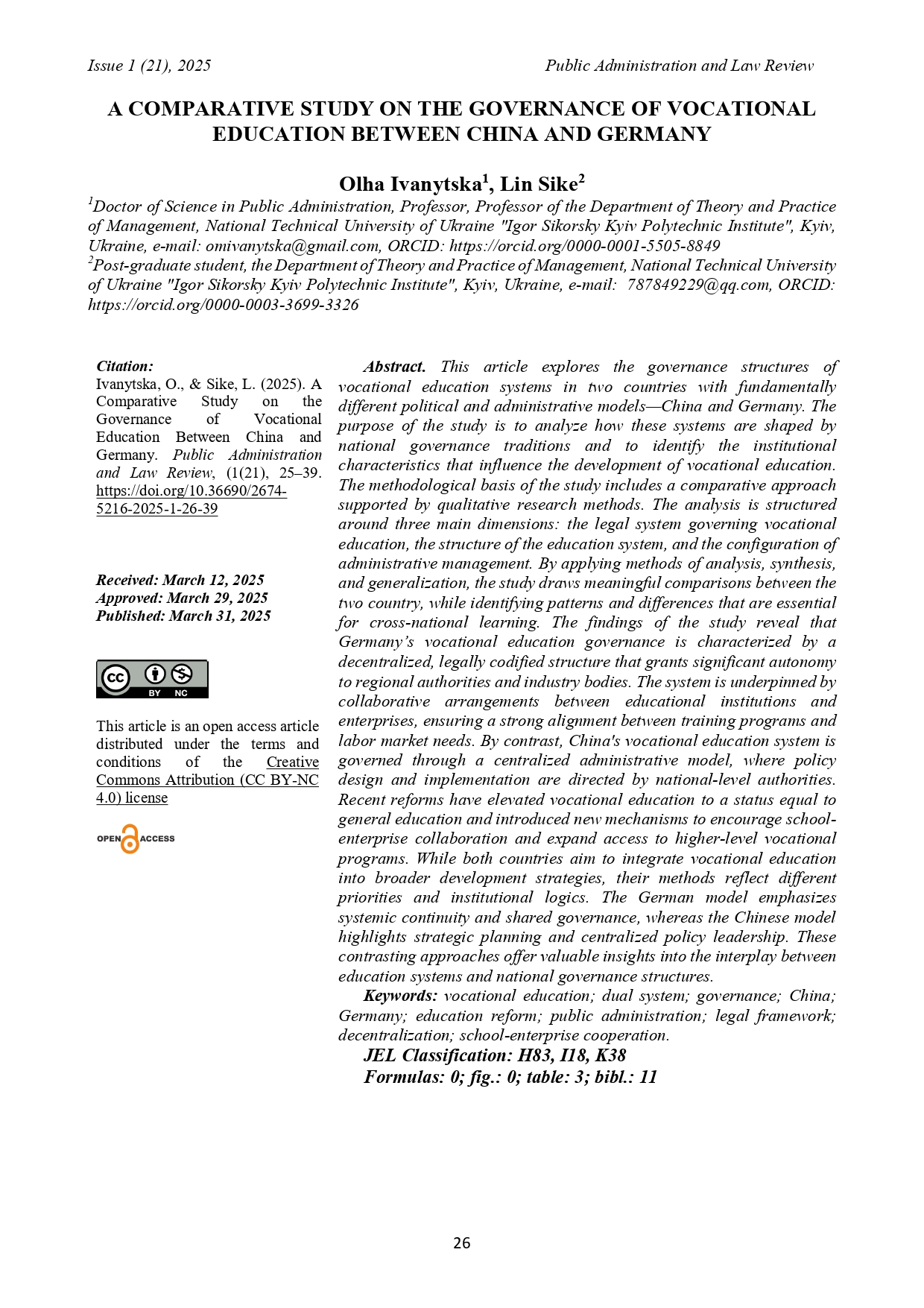A COMPARATIVE STUDY ON THE GOVERNANCE OF VOCATIONAL EDUCATION BETWEEN CHINA AND GERMANY
DOI:
https://doi.org/10.36690/2674-5216-2025-1-26-39Keywords:
vocational education, dual system, governance, China, Germany, education reform, public administration, legal framework, decentralization, school-enterprise cooperationAbstract
This article explores the governance structures of vocational education systems in two countries with fundamentally different political and administrative models—China and Germany. The purpose of the study is to analyze how these systems are shaped by national governance traditions and to identify the institutional characteristics that influence the development of vocational education. The methodological basis of the study includes a comparative approach supported by qualitative research methods. The analysis is structured around three main dimensions: the legal system governing vocational education, the structure of the education system, and the configuration of administrative management. By applying methods of analysis, synthesis, and generalization, the study draws meaningful comparisons between the two country, while identifying patterns and differences that are essential for cross-national learning. The findings of the study reveal that Germany’s vocational education governance is characterized by a decentralized, legally codified structure that grants significant autonomy to regional authorities and industry bodies. The system is underpinned by collaborative arrangements between educational institutions and enterprises, ensuring a strong alignment between training programs and labor market needs. By contrast, China's vocational education system is governed through a centralized administrative model, where policy design and implementation are directed by national-level authorities. Recent reforms have elevated vocational education to a status equal to general education and introduced new mechanisms to encourage school-enterprise collaboration and expand access to higher-level vocational programs. While both countries aim to integrate vocational education into broader development strategies, their methods reflect different priorities and institutional logics. The German model emphasizes systemic continuity and shared governance, whereas the Chinese model highlights strategic planning and centralized policy leadership. These contrasting approaches offer valuable insights into the interplay between education systems and national governance structures.
Downloads
References
Hao, Y. (2023). Xinhua News Agency Commentator: We must take meeting the people's growing needs for a better life as the starting point and end point. https://www.gov.cn/xinwen/2023-03/10/content_5745690.htm
Liu, C. (2023). On the Legislative Innovation and Practical Path of China's Vocational Education Law. Journal of Central China Normal University (Humanities and Social Sciences Edition), (04), 182-188. https:doi:10.19992/j.cnki.1000-2456.2023.04.017.
Liu, S., & Qi, Z. (2017). The Development Process, Basic Characteristics, and Enlightenment of the Vocational Education System in Germany. Contemporary Vocational Education, (06), 104-109. https:doi:10.16851/j.cnki.51-1728/g4.2017.06.021
Modern Higher Vocational and Technical Education Network (2021). Introduction to the Joint Conference of Presidents of National Higher Vocational Schools. https://www.tech.net.cn/news/show-98200.html
Ministry of Education of the People's Republic of China (2018). Notice on Printing and Distributing the "Measures for Promoting School-Enterprise Cooperation in Vocational Schools" by Six Departments Including the Ministry of Education. http://www.moe.gov.cn/srcsite/A07/s7055/201802/t20180214_327467.html
Qiushi Theory Network. (2021). Unwaveringly uphold and strengthen the overall leadership of the Party. http://www.qstheory.cn/dukan/qs/2021-09/15/c_1127862367.htm?
showOutlinkMenu=1&hgWebShareTitle=
Qiushi Theory Network. (2019). Analysis of the Party-government Structure and Functional Mechanism of Contemporary Chinese Governance. http://www.qstheory.cn/llwx/2019-10/17/c_1125115546.htm
Xie, Y. (2018). The Establishment of the Inter-ministerial Joint Conference System for Vocational Education Work of the State Council. The Portal of the Ministry of Education of the People's Republic of China. http://www.moe.gov.cn/jyb_xwfb/s6052/moe_838/ 201811/t20181128_361638.html
Xu, B., & Mi, J. (2011). Analysis of the Vocational Education Regulations in Germany. Vocational and Technical Education, (22), 90-93.
Xinhua News Agency. (2021). Should half of the students attend secondary vocational schools? What is the ratio between general education and vocational education? http://www.xinhuanet.com/politics/2021-06/07/c_1127536280.htm
Yu, S. (2022). After 26 years of first revision—What's new in the new Vocational Education Law? Chinese Government Portal. https://www.gov.cn/xinwen/2022-04/28/content_5687641.htm

Downloads
Published
How to Cite
Issue
Section
License

This work is licensed under a Creative Commons Attribution-NoDerivatives 4.0 International License.





